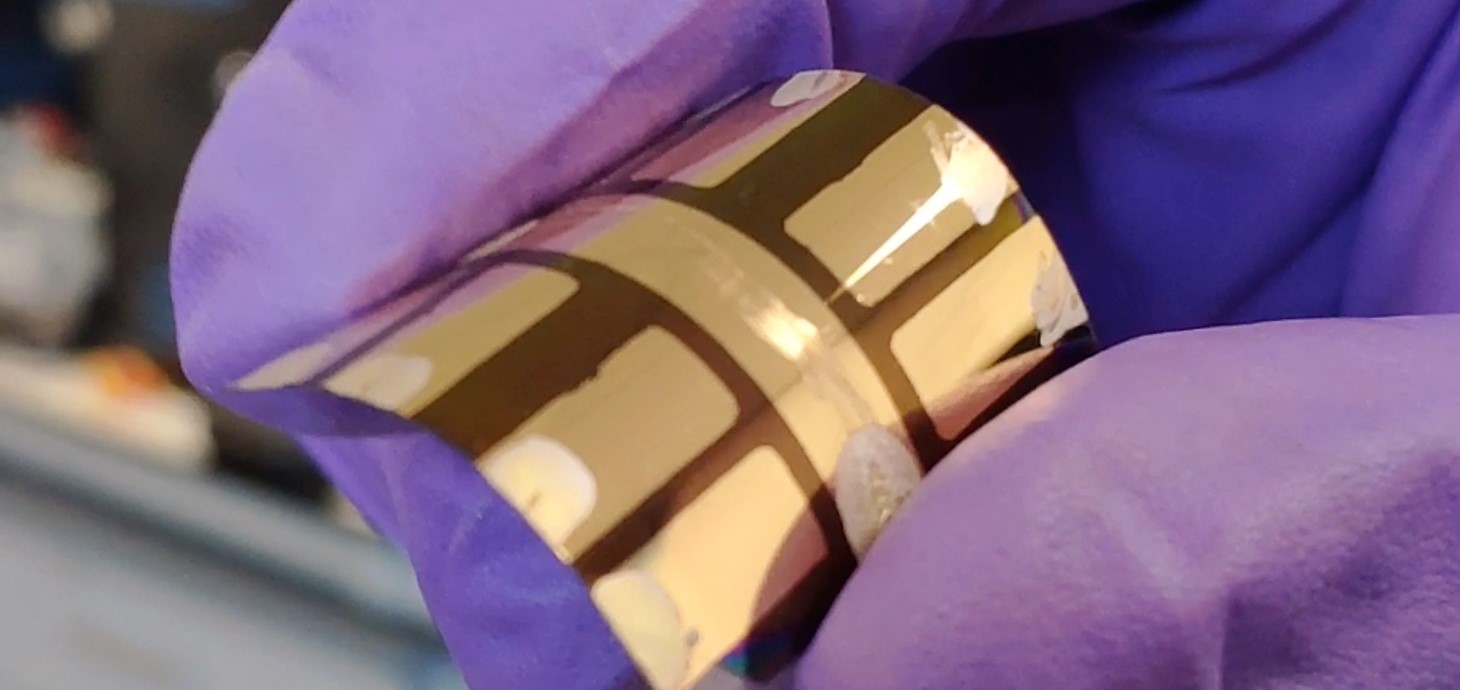These articles are now archived and will no longer be updated.

Flexible solar modules: developed at Swansea University, these can be printed directly onto a flexible base, making them cheaper to manufacture, and suitable for more applications, than traditional solar cells.
A £6 million award will drive next-generation solar technology into new applications.
The grant brings together three world-renowned research groups from Swansea University, Imperial College London and Oxford University to advance organic and perovskite solar cells into applications that current solar technologies are not suitable for.
These next-generation photovoltaics show great promise: their performance competes with current technology, but they have the advantages of being flexible, lightweight, cheap to produce, and they can be printed directly onto products during manufacture.
These properties make them suitable for new applications that will be critical to advances such as:
• 5G, which requires ultra-lightweight sources of power for pseudo-satellites and high-altitude unmanned aerial vehicles (UAVs)
• The Internet of Things, for which sensors and computing devices are increasingly embedded into everyday objects;
• Zero-carbon buildings and vehicles, which could use their roofs, walls and windows to generate power.
The award is a Programme Grant from the Engineering and Physical Sciences Research Council. It will be used by the team to:
• Deliver the fundamental science and engineering to underpin the development of these promising solar technologies;
• Develop low-carbon, low-cost manufacturing methods that will enable them to be produced at scale;
• Develop prototypes to show how they can provide solar power in new applications.
The research programme is called Application Targeted and Integrated Photovoltaics (ATIP).
It will be led by SPECIFIC Innovation and Knowledge Centre at Swansea University in partnership with Swansea’s new Centre for Integrative Semiconductor Materials (CISM), the Centre for Processable Electronics (CPE) at Imperial College London, and Oxford University’s Department of Physics.
It also involves twelve key industry partners from different parts of the supply chain, who understand the technical and cost requirements to deliver new products to market.
The programme will be led by Professor James Durrant FRS from SPECIFIC Innovation and Knowledge Centre.
Professor James Durrant said:
“The fact that the EPSRC has chosen to award this Programme Grant is testament both to the expertise of our team and to the UK’s strength in this field. With these three leading centres working together, we will be able to advance the next generation of solar technologies from the lab to the real world more quickly, for the benefit of the UK and the rest of the world.”
The project has also been backed by the UK’s solar research community.
Professor Michael Walls of Loughborough University, Director of the EPSRC Supergen Solar Network, commented:
"The electricity generated by solar modules has become an important part of the global energy mix. Its continued growth is vital to the UK’s commitment to net zero carbon emissions by 2050. UK researchers have pioneered a new and super-efficient solar technology based on perovskite chemistry. The new EPSRC funded project on ‘Application Targeted and Integrated Photovoltaics’ will take this exciting technology closer to deployment."
EPSRC Executive Chair, Professor Dame Lynn Gladden, said:
“This exciting, multi-disciplinary project represents a step-change in the application of solar power and will help the UK to cut emissions and develop a climate-resilient, zero-carbon economy. The versatility and low cost of this emerging technology also demonstrates how innovative sustainable technologies will help us to improve the way we communicate through 5G and the Internet of Things.”
UK Government Science Minister Amanda Solloway said:
“This funding will allow our brilliant researchers from some of our leading universities to make the next generation of solar technologies a reality. These ground-breaking technologies have the potential to power up zero emissions vehicles, bolster our telecommunications network and provide clean energy for many of the devices we rely on every day. All of this will be essential to building a greener future and achieving net zero by 2050.”
Secretary of State for Wales Simon Hart said:
“With this £6 million investment, the UK Government is backing some of south Wales’ very best scientists and researchers, as they work to advance the next generation of solar technologies. The UK Government funding will accelerate the development of this new, lightweight solar technology, generating benefits for consumers across the world and helping us to reach our target of net-zero emissions by 2050.”
